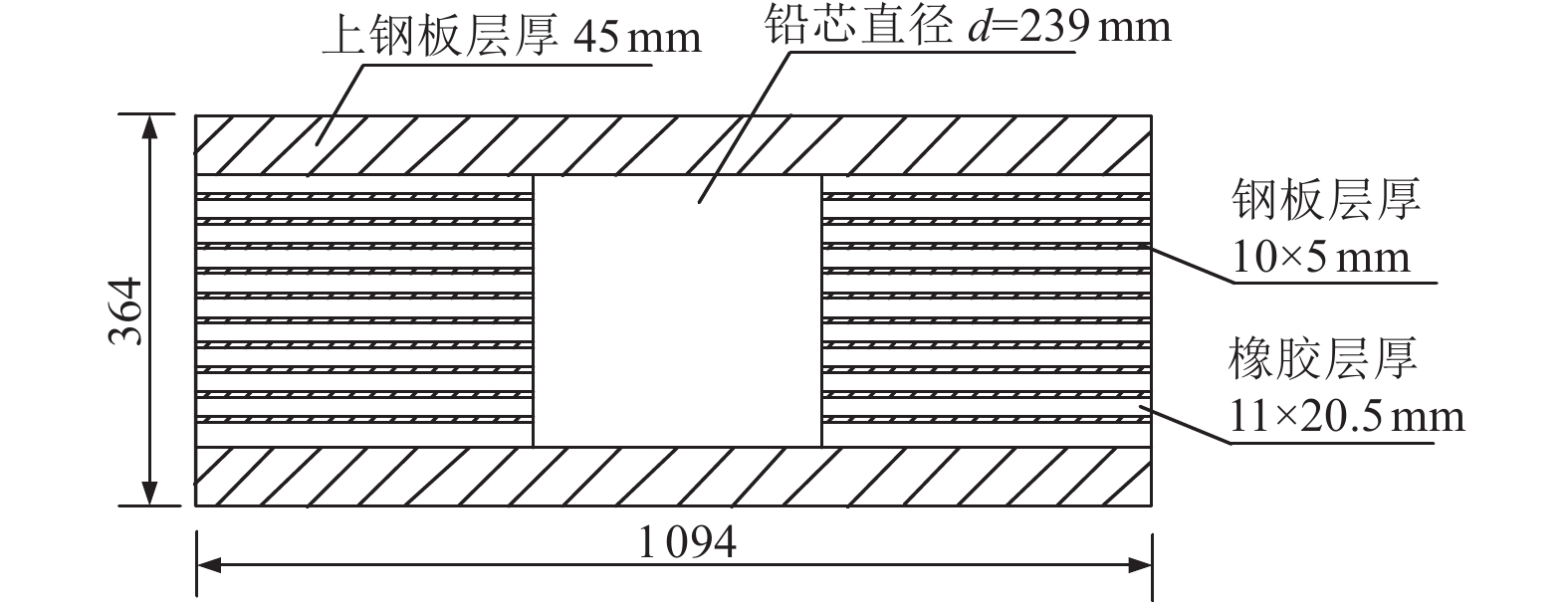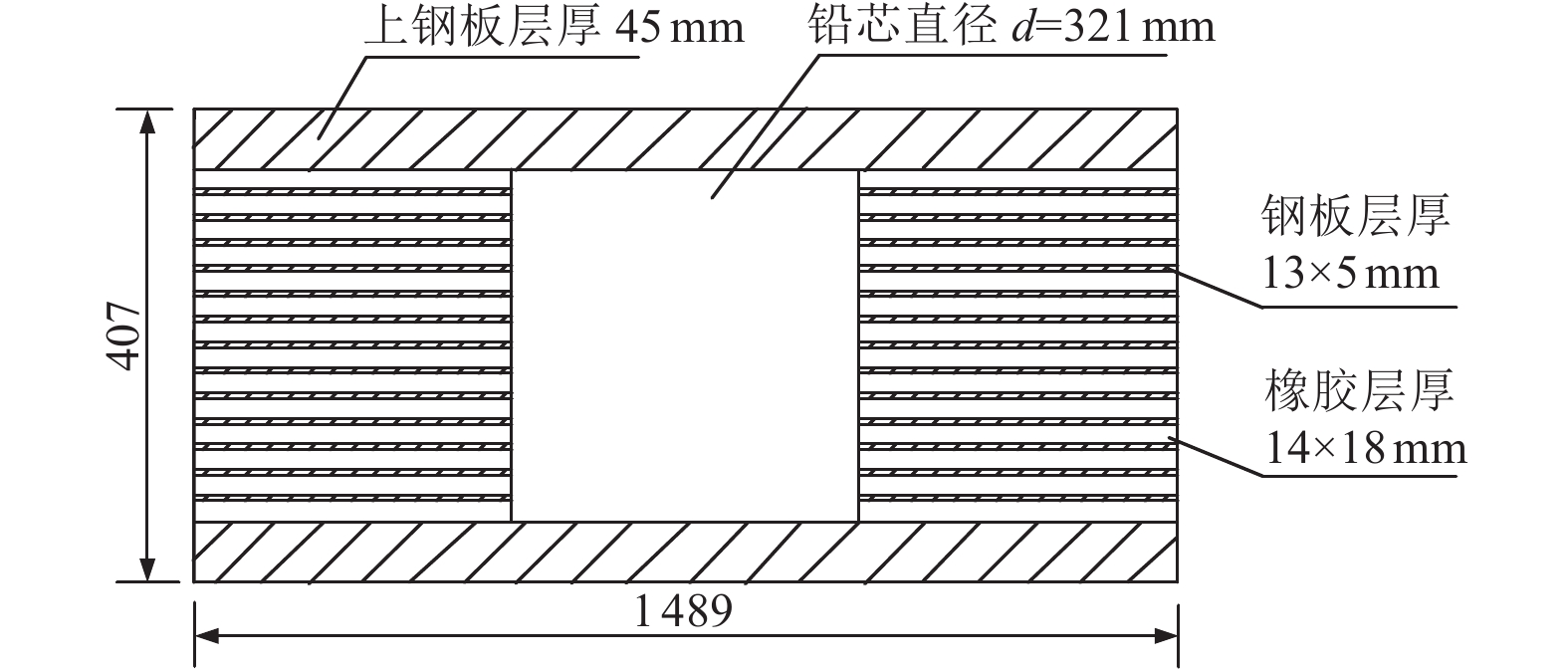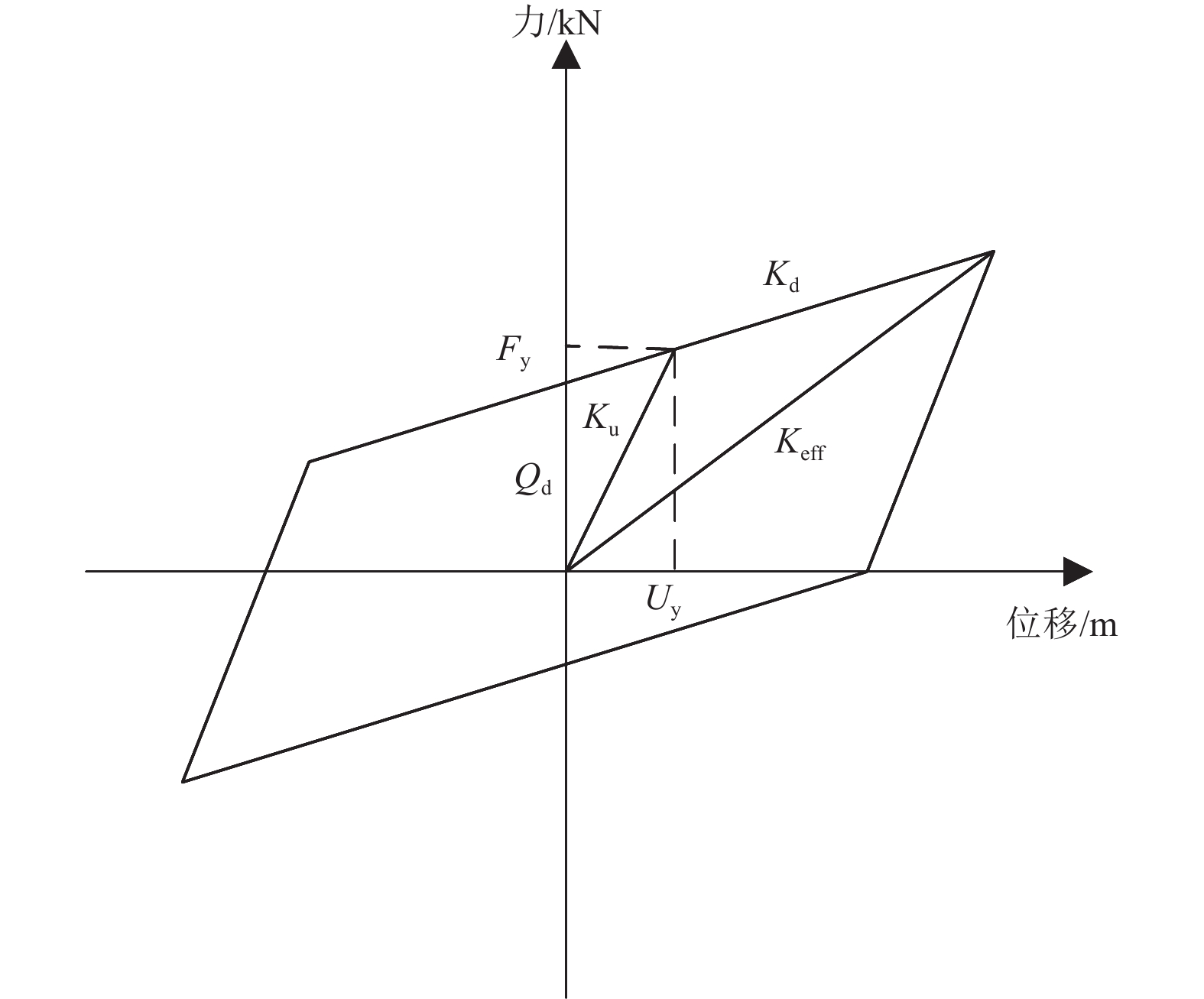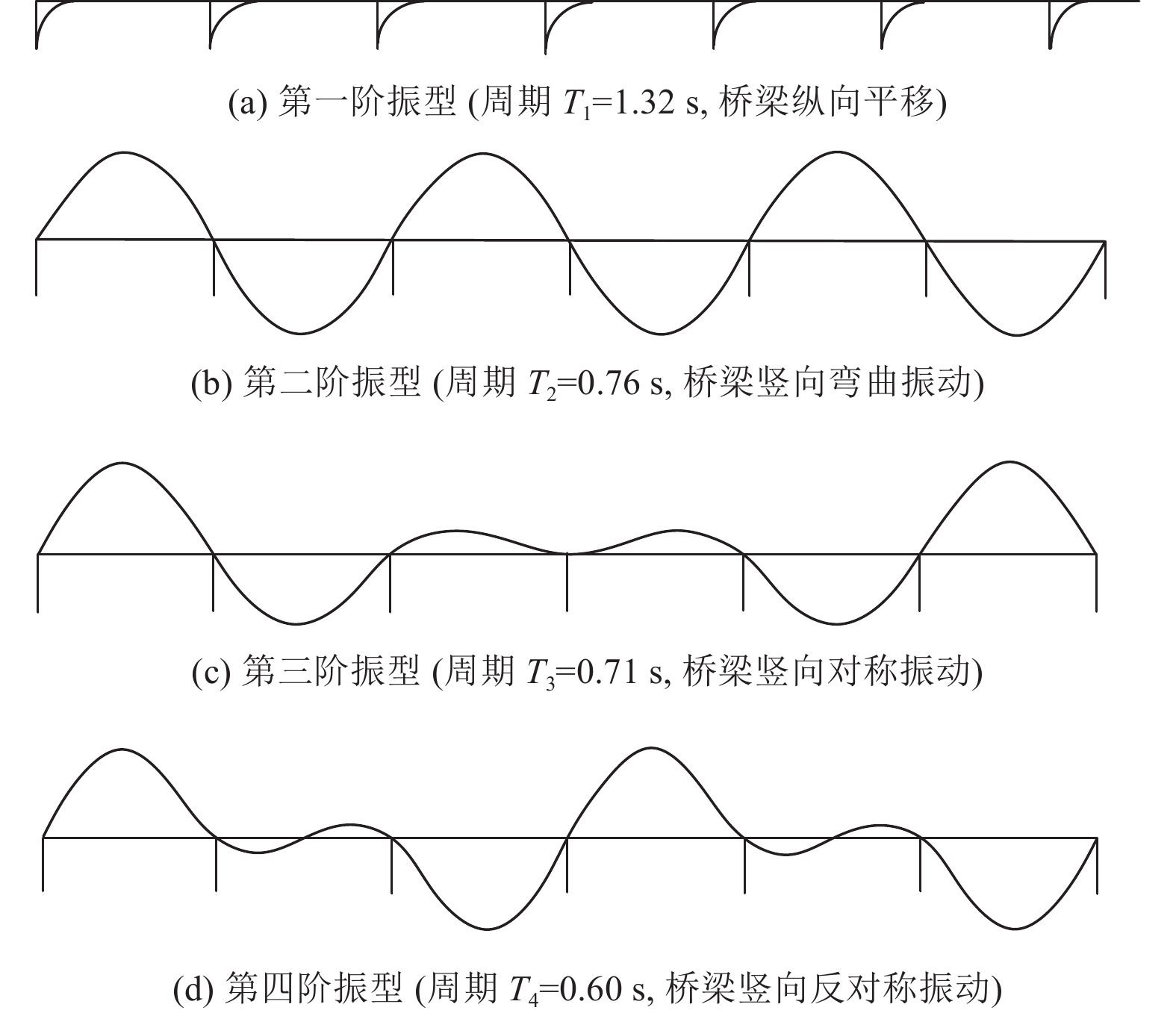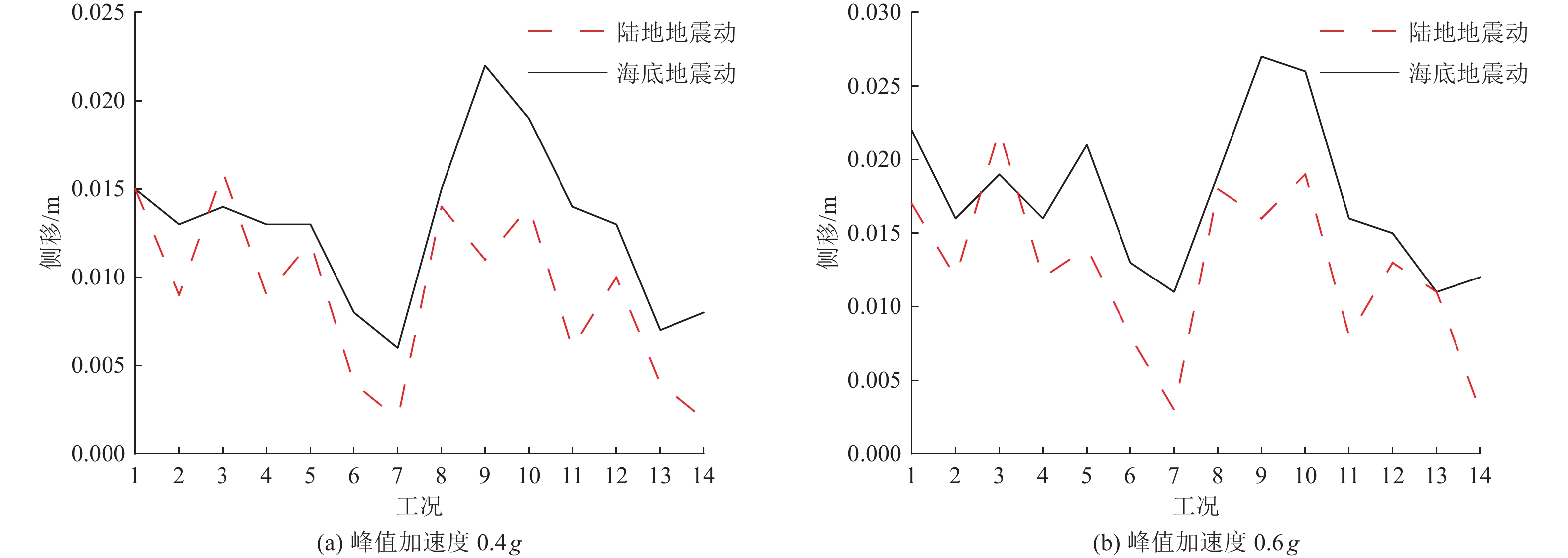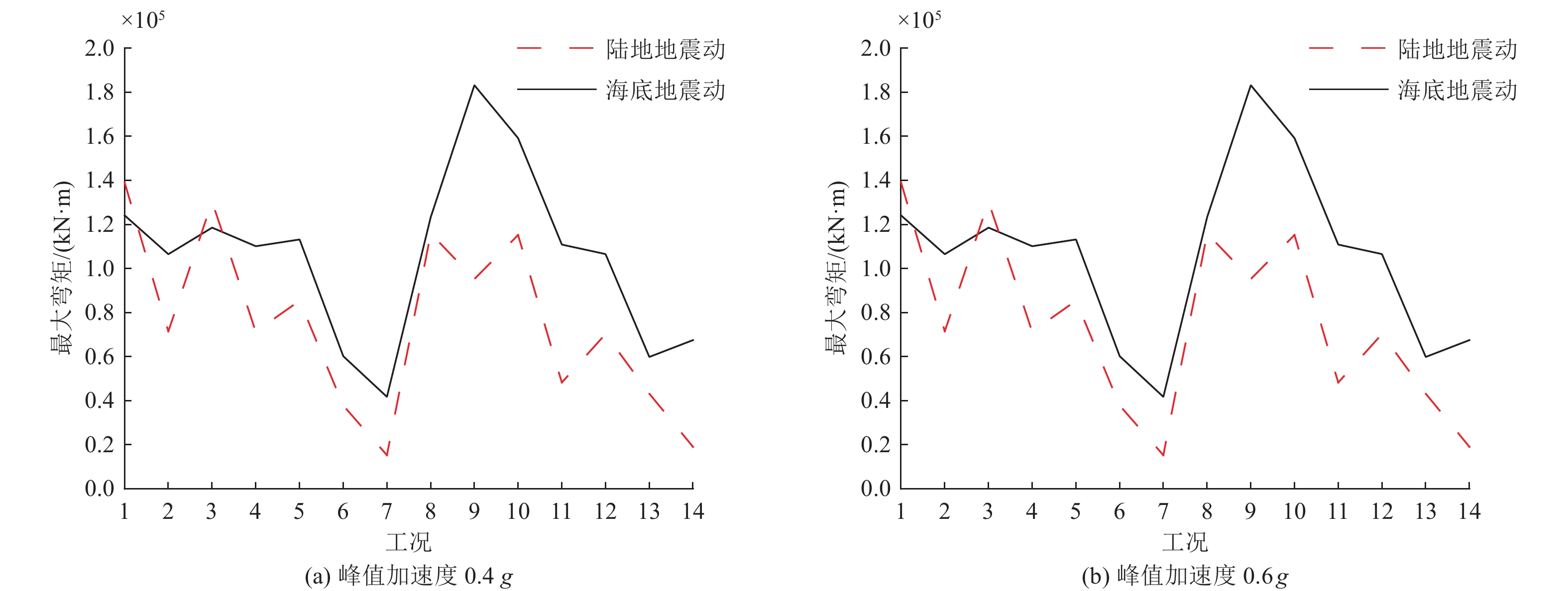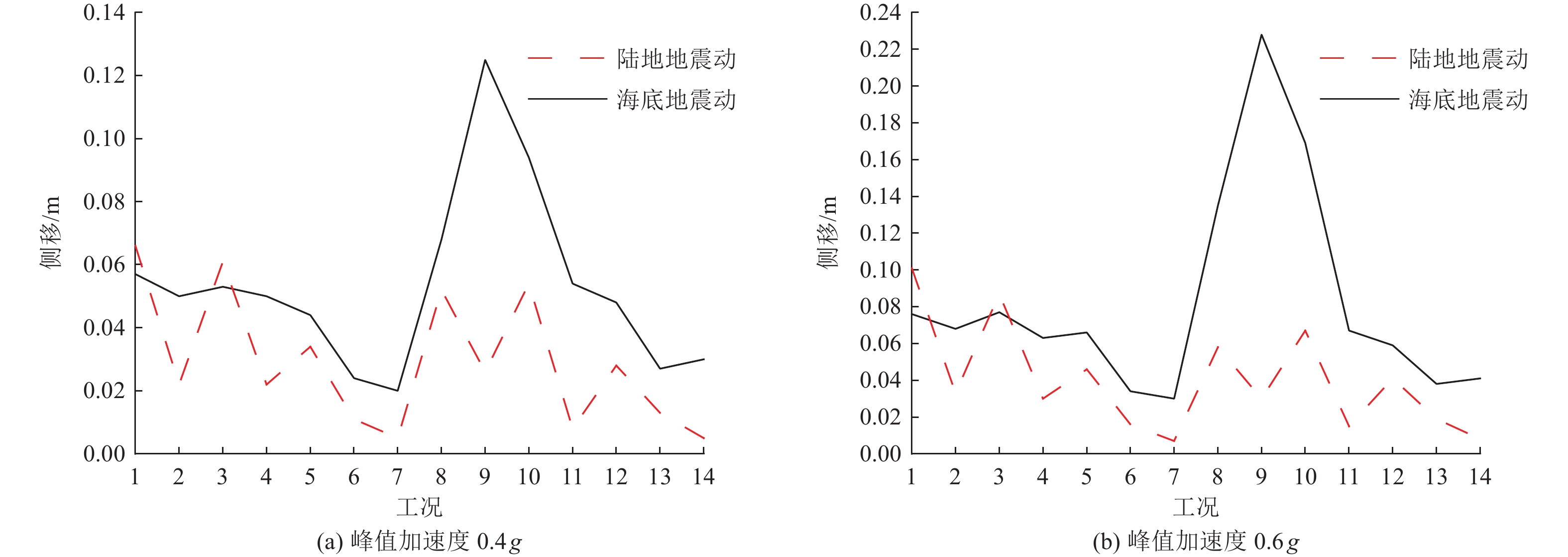Seismic Response Comparison of Sea-crossing and Seismic Isolated Continuous Girder Bridge under Offshore Ground Motion and Onshore Ground Motion
-
摘要: 跨海桥梁抗震时程分析通常采用陆地强震记录作为输入,因海底场地环境与陆地存在诸多差异,需对该方法进行深入研究。结合工程实际,利用ADINA软件建立基底固接跨海隔震连续梁桥分析模型。基于日本KiK-net台网选取震级及震中距相似的7个海底强震台站和7个近岸陆地强震台站各14条水平地震动(EW和NS方向独立考虑),沿桥梁纵桥向输入并进行地震反应时程分析,研究海底地震动和近岸陆地地震动输入下跨海隔震桥梁地震反应。通过对比桥墩最大变形及受力、主梁位移反应和支座最大剪应变,认为在大多数情况下,海底地震动作用下桥梁结构地震反应为近岸陆地地震动的1.3~1.9倍。跨海隔震桥梁抗震时程分析宜采用海底地震动作为输入。Abstract: The strong earthquake records onshore usually are input as seismic time history analysis of cross-sea bridges. Because of the differences between the environment of the seabed and the land, this method needs to be studied carefully. Taking a real cross-sea isolated continuous beam bridge as the example, the analysis model of the sea-crossing bridge is established by ADINA software with the fixed-base assumption. Based on the Japanese KIK-net network, 7 submarine strong earthquake stations and 7 coastal land strong earthquakes with similar magnitude and epicenter distance are selected, each site conditions with 14 horizontal (independently considered EW and NS directions) seismic records. The seismic records are input along the longitudinal direction of the bridge for seismic response time history analysis. The seismic response of a sea-crossing isolated continuous beam bridge under different two ground motion input modes is studied, one is the offshore ground motions, the other is onshore ground motions. The maximum deformation and force of the bridge pier, the displacement response of the main girder and the maximum shear strain of the bearing are compared. It is known that, the responses of bridge structure subjected to the offshore ground motions are greater than that subjected to the onshore ground motions in most cases with response ratios being up to 1.3 to 1.9 times. Therefore the offshore seismic records should be input for seismic time history analysis of sea-crossing isolated bridge.
-
表 1 主梁材料参数
Table 1. Main girder material parameters
材料编号 材料名称 弹性模量/MPa 泊松比 密度/
(kg·m−3)1 C50混凝土 34 500 0.2 2 549 2 Q345钢 206 000 0.3 7 849 表 2 理想双线性建模参数
Table 2. Ideal bilinear modeling parameters
支座位置 Ku/(kN·m−1) Kd/(kN·m−1) Fy/kN KV/(kN·m−1) 边墩支座 32 780 4 000 449 1 667 000 中墩支座 51 970 6 652 810 4 724 000 表 3 地震动台站信息(海底地震动)
Table 3. Detailed data of ground motion station
序号 站台编号 时间/(年-月-日) 东经/(°) 北纬/(°) 1 KNG204 2006-04-21 139.57 34.89 2 KNG203 2006-04-21 139.64 34.80 3 SZ0003 2006-04-21 139.05 34.82 4 KNG206 2006-04-21 139.38 35.10 5 KNG201 2018-07-07 139.92 34.60 6 SIT008 2015-09-12 139.75 35.98 7 CHB028 2015-09-12 139.97 35.77 表 4 地震动台站信息(近岸陆地地震动)
Table 4. Detailed data of ground motion station
序号 站台编号 时间/(年-月-日) 东经/(°) 北纬/(°) 1 CHB012 2020-06-25 140.33E 35.57N 2 IBR017 2020-06-25 140.32E 35.95N 3 CHB004 2020-06-25 140.49E 35.90N 4 MYG002 2020-09-12 141.51E 38.73N 5 MYG003 2020-09-12 141.31E 38.73N 6 IWT026 2020-09-12 141.10E 39.26N 7 IWT009 2020-09-12 141.40E 39.02N -
陈宝魁, 王东升, 石岩等, 2017. 跨海桥梁抗震设计研究发展综述. 世界地震工程, 33(4): 122—128Chen B. K. , Wang D. S. , Shi Y. , et al. , 2017. Advancement in research on seismic design of sea-crossing bridge. World Earthquake Engineering, 33(4): 122—128. (in Chinese) 陈宝魁, 卢宏飞, 宋固全等, 2020. 海底地震动作用下隔震桥地震反应. 南昌大学学报(工科版), 42(3): 233—241 doi: 10.3969/j.issn.1006-0456.2020.03.006Chen B. K. , Lu H. F. , Song G. Q. , et al. , 2020. Seismic response of the sea-crossing isolated bridge under offshore ground motion. Journal of Nanchang University (Engineering & Technology), 42(3): 233—241. (in Chinese) doi: 10.3969/j.issn.1006-0456.2020.03.006 李超, 2017. 海底空间地震动作用下近海桥梁结构全寿命易损性分析. 大连: 大连理工大学.Li C., 2017. Life-cycle seismic fragility analyses of offshore bridge structures subjected to spatially varying seafloor motions. Dalian: Dalian University of Technology. (in Chinese) 李小军, 李娜, 陈苏, 2021. 中国海域地震区划及关键问题研究. 震灾防御技术, 16(1): 1—10 doi: 10.11899/zzfy20210101Li X. J. , Li N. , Chen S. , 2021. Study on seismic zoning in China sea area and its key issues. Technology for Earthquake Disaster Prevention, 16(1): 1—10. (in Chinese) doi: 10.11899/zzfy20210101 刘驭, 2019. 海底地震动作用下近海桥梁动力响应研究. 大连: 大连交通大学.Liu Y., 2019. Dynamic response of offshore bridges under seabed ground motions. Dalian: Dalian Jiaotong University. (in Chinese) 谭景阳, 胡进军, 周旭彤等, 2020. 考虑不同分类的海底地震动特性及其不确定性分析. 天津大学学报(自然科学与工程技术版), 53(12): 1264—1271Tan J. Y. , Hu J. J. , Zhou X. T. , et al. , 2020. Characteristics and uncertainty of classified seafloor ground motion. Journal of Tianjin University (Science and Technology), 53(12): 1264—1271. (in Chinese) 王德斌, 刘驭, 张蓬勃等, 2019. 海底地震动作用下近海桥梁地震响应研究. 世界地震工程, 35(3): 63—72Wang D. B. , Liu Y. , Zhang P. B. , et al. , 2019. Seismic response of offshore bridges under seabed seismic motion. World Earthquake Engineering, 35(3): 63—72. (in Chinese) 王明远, 张星雷, 袁涌, 2011. 厦漳跨海大桥引桥隔震效果分析. 土木工程与管理学报, 28(3): 382—384 doi: 10.3969/j.issn.2095-0985.2011.03.085Wang M. Y. , Zhang X. L. , Yuan Y. , 2011. Dynamic characteristic research in the seismic response analysis of the Xiazhang Cross-sea Bridge. Journal of Civil Engineering and Management, 28(3): 382—384. (in Chinese) doi: 10.3969/j.issn.2095-0985.2011.03.085 张广锋, 任伟新, 陈亮等, 2013. 东日本大地震中抗震加固后的公路桥的震害特点. 土木工程学报, 46(S1): 239—244 doi: 10.15951/j.tmgcxb.2013.s1.018Zhang G. F. , Ren W. X. , Chen L. , et al. , 2013. Seismic damage of retrofitted highway bridges in the 2011 Great East Japan Earthquake. China Civil Engineering Journal, 46(S1): 239—244. (in Chinese) doi: 10.15951/j.tmgcxb.2013.s1.018 周旭彤, 胡进军, 谭景阳等, 2021. 基于HVSR的DONET1海底地震动场地效应研究. 震灾防御技术, 16(1): 105—115 doi: 10.11899/zzfy20210111Zhou X. T. , Hu J. J. , Tan J. Y. , et al. , 2021. The study of site effect of DONET1 offshore ground motions based on HVSR. Technology for Earthquake Disaster Prevention, 16(1): 105—115. (in Chinese) doi: 10.11899/zzfy20210111 Boore D. M. , Smith C. E. , 1999. Analysis of earthquake recordings obtained from the Seafloor Earthquake Measurement System (SEMS) instruments deployed off the coast of southern California. Bulletin of the Seismological Society of America, 89(1): 260—274. doi: 10.1785/BSSA0890010260 Chen B. K. , Wang D. S. , Li H. N. , et al. , 2015. Characteristics of earthquake ground motion on the seafloor. Journal of Earthquake Engineering, 19(6): 874—904. doi: 10.1080/13632469.2015.1006344 Chen B. K. , Wang D. S. , Li H. N. , et al. , 2017. Vertical-to-horizontal response spectral ratio for offshore ground motions: analysis and simplified design equation. Journal of Central South University, 24(1): 203—216. doi: 10.1007/s11771-017-3421-0 Ganev T. , Yamazaki F. , Ishizaki H. , et al. , 1998. Response analysis of the Higashi-Kobe Bridge and surrounding soil in the 1995 Hyogoken-Nanbu earthquake. Earthquake Engineering & Structural Dynamics, 27(6): 557—576. Penzien J. 2001. Earthquake engineering for transportation structures—past, present, and future. Earthquake Spectra, 17(1): 1-34 Kitagawa M. , 2004. Technology of the Akashi Kaikyo bridge. Structural Control and Health Monitoring, 11(2): 75—90. doi: 10.1002/stc.31 Li C. , Hao H. , Li H. N. , et al. , 2015. Theoretical modeling and numerical simulation of seismic motions at seafloor. Soil Dynamics and Earthquake Engineering, 77: 220—225. doi: 10.1016/j.soildyn.2015.05.016 Li T. H. , Lin J. Q. , Liu J. L. , 2020. Analysis of time-dependent seismic fragility of the offshore bridge under the action of scour and chloride ion corrosion. Structures, 28: 1785—1801. doi: 10.1016/j.istruc.2020.09.045 Swanger H. J., 1981. Surface waves in strong ground motion with applications to offshore environments. Palo Alto: Stanford University. Wilson J. C. , 2003. Repair of new long-span bridges damaged by the 1995 Kobe earthquake. Journal of Performance of Constructed Facilities, 17(4): 196—205. doi: 10.1061/(ASCE)0887-3828(2003)17:4(196) -




 下载:
下载:

